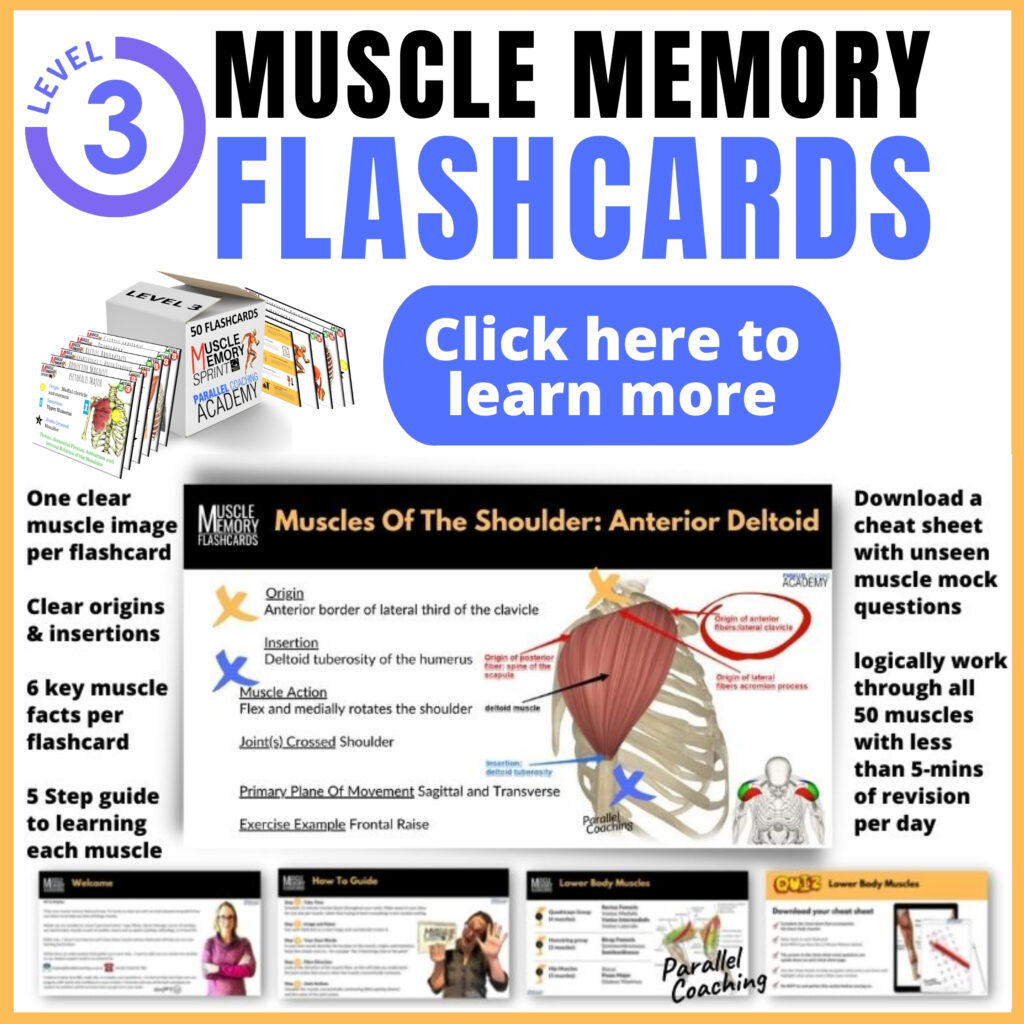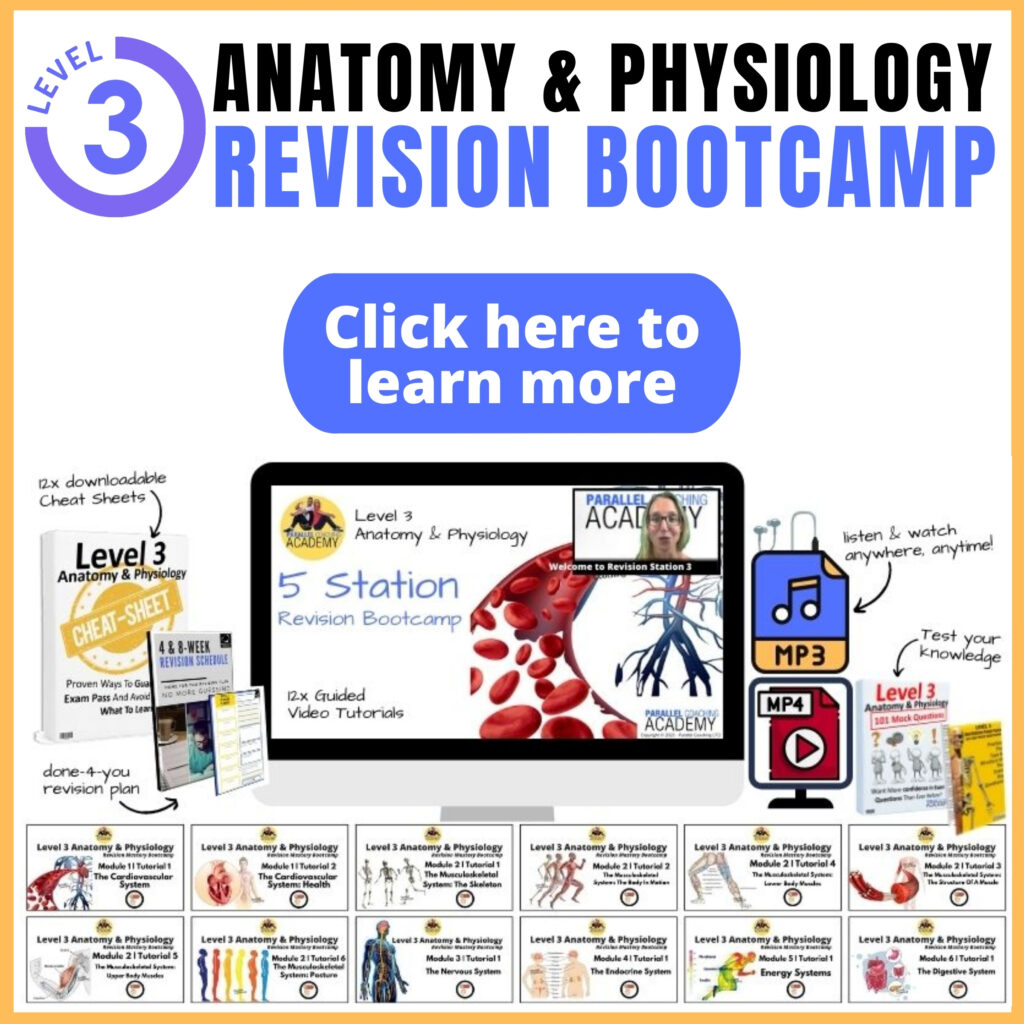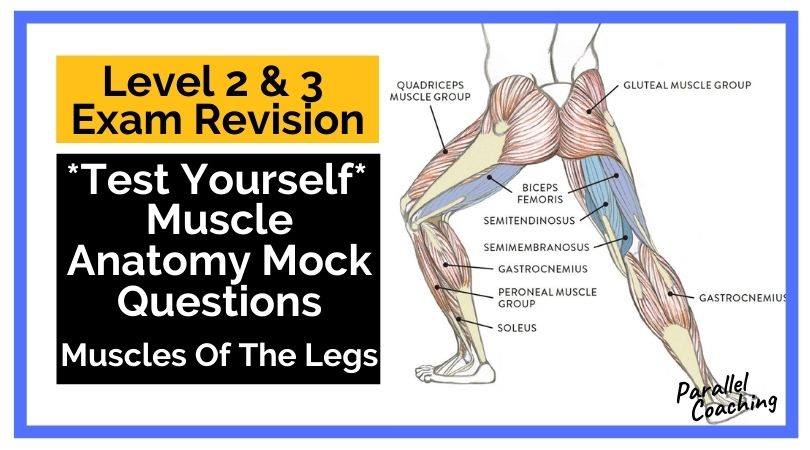This blog will test your knowledge of the Muscles of the leg with TEN Muscle Anatomy Mock Questions, mapped to your Level 2 and 3 Anatomy exam.
You’ll discover:
- The information you need to know about the Quadriceps, Hamstrings, Gastrocnemius, Adductors, and Abductors
- A summary of all muscles of the legs
- TEN Muscle Anatomy Mock Questions and answers to test your knowledge
The majority of muscles in the leg are considered long muscles, in that they stretch great distances.
As these muscles contract and relax, they move skeletal bones to create movement of the body.
Smaller muscles help the larger muscles, stabilize joints, help rotate joints, and facilitate other fine-tuned movements.
The largest muscle masses in the leg are present in the thigh and the calf.
Quadriceps Muscles:
The muscles that make up the quadriceps are the strongest of all muscles in the body. These four muscles at the front of the thigh are the major extensors (help to extend the leg straight) of the knee.
They are:
- Vastus lateralis,
- Vastus medialis,
- Vastus intermedius,
- Rectus femoris
For the Level 2 Anatomy exam you need to know the names of all four muscles within the Quadriceps, the muscle action and location. At level 3 you will need to know the detailed origins and insertions.
Each of the Quadricep muscles have different origin points. However, they all cross the knee and insert on the tibia. They all have main joint action of Knee extension.
The Rectus Femoris crosses the Hip and the Knee, originating on the Anterior Inferior Iliac Spine (front of the pelvis). This means that the Rectus Femoris also create Hip Flexion during concentric contraction.
Deep Dive into the quadriceps muscles HERE
Hamstring Muscles:
The hamstrings are three muscles at the back of the thigh that affect hip and knee movement. They are:
- Biceps femoris,
- Semimembranosus,
- Semitendinosus
They ALL originate on the Ischium (sits bones) and attach below the knee.
The Biceps femoris inserts on the Fibula and the other two muscles insert onto the Tibia.
During concentric contraction the hamstrings main joint actions are extension of the hip and flexion of the knee
Learn How to Remember the Hamstrings HERE
Calf Muscles:
The calf muscles are pivotal to movement of the ankle, foot, and toes. Some of the major muscles of the calf include:
- Gastrocnemius (calf muscle)
- Soleus
Possibly the most important tendon in terms of mobility is the Achilles tendon. This important tendon in the back of the calf and ankle connects the plantaris, gastrocnemius, and soleus muscles to the heel bone. It stores the elastic energy needed for running, jumping, and other physical activity.
It is important to know that hte Gastrocnemius crosses both the Knee and the ankle, whereas the soleus only crosses the ankle.
The main action caused by these two muscles is plantarflexion of the ankle (pointing your toes away from the nose).
The antagonistic muscle to this would be the Anterior Tibialis in the front of the shin, which created Dorsiflexion at the ankle (toes to nose)
Adductors and Abductors:
The Adductors are responsible for drawing the leg into the midline, and make up the muscles of the inner thigh.
The Adductor Group is made up of Five muscles:
- Adductor Magnus
- Adductor Longus
- Adductor Brevis
- Pectineus
- Gracilis
Learn more about the 5 adductor muscles HERE
The Adductors are the antagonists to the Abductor Muscles which spread across the outside of the bum and upper thigh. These are responsible for abducting the hip ( taking the leg away from the midline), and externally rotating the hip.
The Abductor group includes:
- Gluteus Minimus
- Gluteus Medius
- Tensor Fascia Latae
Got questions about your revision, or want more mock questions: MESSAGE US HERE
In summary
- The Quadriceps are on the front of the thigh and create Knee Extension
- The Hamstrings are on the back of the thigh and create Knee Flexion
- The Adductors are on the inside of the thigh and create Hip Adduction
- The Abductors are on the outside of the hip and create Hip Abduction
- Check out the TEN Mock Questions Below to check your knowledge
- Here’s what Lydia had to say about the A&P Revision Mastery Bootcamp
I can’t recommend Parallel Coaching enough their learning material is fantastic and definitely was a huge factor in me passing my A&P level 3!
Lydia
How to learn orgins and insertions?
Learn, Revise & Remember All 50 Muscles In The Level 3 Anatomy & Physiology Exam.
(and the BEST part…You can do all this in as little as 5-minutes a day)
Each flashcard gives you a clear image and six clear muscle facts:
- Name and Location
- Origin and Insertions
- Muscle Actions
- Joints Crossed
- Primary Planes Of Movement
- Exercise Examples

Test your knowledge with TEN Muscle Anatomy Mock Questions
Look at the TEN Muscle Anatomy Mock Questions below and jot down your answer on a scrap paper or as a note on your phone.
Then scroll down to reveal the answers.
Q1. Which muscle does not belong to the Hamstring Group?
A. Biceps Femoris
B. Rectus Femoris
C. Semitendinosis
D. Semimembranosis
Q2. Which of the following is not an Adductor of the hip?
A. Pectineus
B. Gracilis
C. Tensor Fascia Latae
D. Adductor Longus
Q3. Which Muscle group has the primary role of Knee Flexion?
A. Quadriceps
B. Adductors
C. Abductors
D. Hamstrings
Q4. Which Quadricep muscle crosses both the knee and the hip?
A. Rectus Femoris
B. Vastus Lateralis
C. Biceps Femoris
D. Vastus Medialis
Q5. Which muscle originates on the ischium and inserts on the Tibia, causing knee flexion?
A. Semitendinosis
B. Biceps Femoris
C. Vastus Lateralis
D. Rectus Femoris
Q6. Which muscle crosses both the knee and the ankle?
A. Biceps Femoris
B. Soleus
C. Gastrocnemius
D. Adductor Magnus
Q7. When the hamstring group contract concentrically what join action occurs at the knee?
A. Extension
B. Flexion
C. Lateral Flexion
D. Adduction
Q8. When the quadriceps group contracts concentrically what join action occurs at the knee?
A. Extension
B. Flexion
C. Lateral Flexion
D. Adduction
Q9. When the gastrocnemius contracts concentrically which action occurs at the ankle?
A. Dorsiflexion
B. Lateral Flexion
C. Lateral Extension
D. Plantarflexion
Q10. Which of the following is an Abductor Muscle?
A. Tensor Fascia Latae
B. Pectineus
C. Vastus Lateralis
D. Soleus
Answers:
Q1: = B
Q2: = C
Q3: = D
Q4: = A
Q5: = A
Q6: = C
Q7: = B
Q8: = A
Q9: = D
Q10 = A
If you want more mock questions like this, then you can download more Free Mock Questions: DOWNLOAD NOW
Need More Help with your Level 3 Anatomy Revision?
For Trainee FITPROS Taking Their L3 Anatomy & Physiology Exam.
Learn, Revise & Pass Your Level 3 Anatomy & Physiology Exam In Under 10-hours
(Without Having To Spend Hours Revising Or Feeling Overwhelmed)
If you want to get your revision structured, learn everything you need to know, and feel confident on exam day, then click the link below:

Dedicated to More
Hayley “Muscle Anatomy Mock Questions” Bergman
Parallel Coaching
P.S. You can also find us on the following platforms:
Instagram: Follow Now
Facebook: Like Our Page
Twitter: Tweet Us
YouTube: Subscribe Here
More Muscle Revision Blogs: HERE

